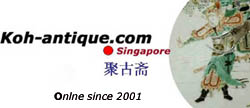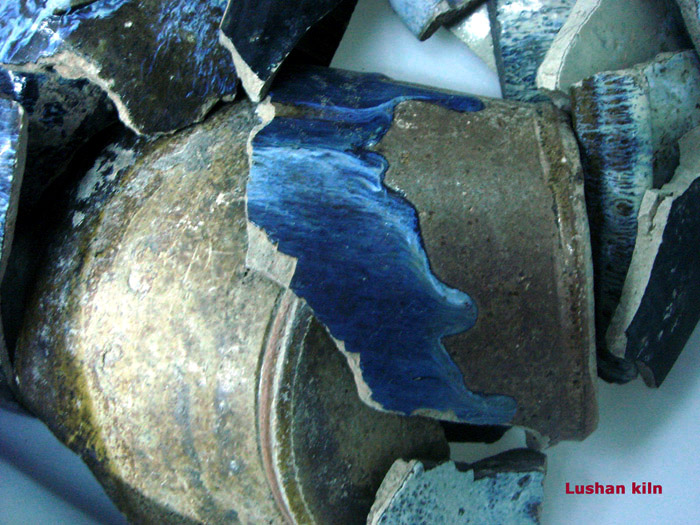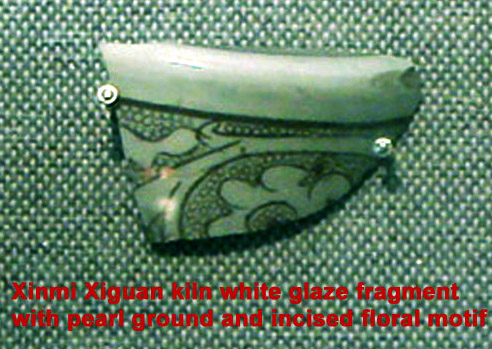
Henan Ceramics wares (河南陶瓷)
Tang/5 Dynasty Period
During the Tang Dynasty, kilns in Northern China produced predominantly White wares and smaller number of green glazed wares. In the area of lead glazed wares, there were tremendous progress made, the greatest achievement being the magnificent Tang Sancai wares. In Henan, the area producing ceramics also expanded. Some of those kilns had very long production history and continued to produce ceramics till the Yuan/Ming period.
Yellow/Amber Glaze wares
During the Tang period, a form of iron-oxide yellow/amber colour high fired glaze vessel was introduced by the Shouzhou (寿州) potters from Anhui province. Shouzhou was a famous kiln mentioned in Lu Yu's Treatise on Tea (陆羽茶经). It was a popular product and kilns in Hebei and Henan also produced them. In Henan, some of the more notable kilns producing such wares were Jiaxian Huangdao (郏县黄道窑), Gongyi Huangye (巩义黄冶窑), Xinmi Xiguan (新密西关窑), Dengfeng Zhudong (登封朱洞窑), Yuzhou Changzhuang (禹州苌庄窑) and etc.
| Two examples from Dengfeng kiln. The ewer on the left has impressed straw-mat motif. This was a popular treatment on Tang ewers with yellow or yellowish green glaze | |
| Amber glaze ewer from Dengfeng
kiln. It has interesting Jun effect opalescent bluish white splashes on the body |
| Some other amber glaze samples from Dengfeng kiln |
Black/brown Glazed wares
Many Northern kilns of the period also produced black, brownish black and teadust wares. An interesting variation was the addition of splashes of opalescent whitish or whitish blue glaze over the ground dark brown glaze. The Chinese called it hua you (花釉).Many of the Chinese experts believe such wares were the precursor of Song Jun wares. Typical shapes with such glazes included drum, jar and plates. The most famous kilns producing such wares were Lushan Dudian (鲁山段店窑) and Jiaxian Huangdao (郏县黄道窑). Other less well known kilns which also produced them were Dengfeng Zhudong (登封朱洞窑) and Yuzhou Changzhuang (禹州苌庄窑) and etc.
 |
|
| The splashes could be an opaque powdery white colour. If fired at a higher temperature, it intermingled well with the ground glaze. Some has a shiny , more transparent bluish white as can been seen in above. | |
Lushan Huayou ci (鲁山花釉瓷) drum and Beijing Palace Museum
Samples from Dengfeng kiln
White/white glaze green splashes wares
White glaze ware was the most iconic ceramics product of Northern China during Tang Dynasty. In fact, so far we are still unable to find kilns in Southern China that produced them during this period. The most famous white glaze ware production site was Xing kiln in Hebei. In Henan, besides the typical plain white glaze wares, some kilns also produced white wares which used various decorative techniques. One of the most notable type was high fired white glaze with splashes of copper green. This should be differentiated from the low fired lead glaze with green splashes. They were especially popular during the Tang/5 Dynasty period. Towards the 5 Dynasty period, besides the abstact splashes, stylised floral motif was introduced. Some of the notable kilns producing such wares were Xinmi Xiguan (新密西关窑), Dengfeng Quyang (登封曲阳窑), Lushan Dudian (鲁山段店窑) and Anyang Beiqi (安阳北齐窑).
| Anyang Beiqi kiln 5 Dynasty white glaze gourd-shaped vase and jar with handle decorated with green splashes | Dengfeng Zhudong kiln dish decorated with floral-like motif. Most probably dated to 5 Dynasty/Northern Song |
Xinmi Xiguan (新密西关窑) also introduced a form of white ware with stamped pearl-like ground and incised motif during the late Tang period. Such decorative technique gained much popularity during the Northern Song period. A number of kilns were known to produce such wares, the most famous being Dengfeng Quhe kiln (登封曲阳窑).

Wares with Brown glaze decoration on biscuit
Yaozhou kiln was the first discovered to produce vessels with brown glaze decoration on biscuit body. A typical composition consisted of rim of bowl/plate covered with brown patches to form a star-shaped unglaze surface on the interior. This area is usually painted with stylised floral motif. This decorative technique was adopted by Henan potters during the 5 Dynasty/Northern Song period. Two examples are shown below. The censer on the right is from Dengfeng Zhudong kiln (登封朱洞窑). The biscuit body is decorated with abstract floral motif.
|
|
|
|
|
|
Examples from Dengfeng kiln
Tang Sancai wares
One of the finest achievements of Henan potters were made in the area of lead glazed wares. Besides version of lead glaze white wares with splashes of green, the kilns in Gongyi (previously called Gongxian) Huang Ye (巩义黄冶) and Gongyi Baihe (巩义白河) further developed the decorative techniques with multi-coloured glazes called Tang Sancai or Tang Tri-colour. The term is rather misleading as the number of colours can vary from 1 to more than 3. There was a range of colours including white, green, blue, black, brown, amber and dark brown. The vessel which was first coated with a white slip and fired to around 1000 degree centigrade. It was then glazed and fired at a lower temperature of about 800 degree centigrade. Vessels included plates, bowls, jars, censers and figurines of court official, servant, lady, camel, horse and models of building. Most of such wars were produced for elaborate burial purposes. So far, very few kiln wastage of large figurines have been excavated. Very likely there were other kilns that specialised in production of such products not discovered yet. Some of the utilitarian vessels such as censer, bowls, plates and etc were exported overseas and had been found in Middle East, Japan and Indonesia.
Duck shaped pot in the Henan Museum
Tang Sancai Court servants in Loyang Museum
Gongyi Huangye kiln white glaze with green splashes
Gongyi kilns also made an interesting type of marbled wares. It involved a process of inter-mixing two types of clay which is grayish white and brownish in colour respectively. The end result is an interesting tree-like grain or cloud like design.
Tang Marbled vessel in Shanghai Museum
An interesting variation employed the application of thin layers of such marbled clay on different part of the vessel.
|
Tang Marbled pillow vessel in Shanghai Museum.
Tang Blue and white wares
Another technical breakthrough was the production of high fired underglaze cobalt blue and white. Some blue and white sherds have been discovered in Gongyi Baihe kiln (巩义白河窑). They consisted of simple geometric and floral design. The composition of the blue and white wares showed clear Middle Eastern influence as can been seen on the 3 dishes found in the Belitung shipwreck.

Dish from the Belitung Tang Shipwreck
The Gongyi kilns also produced some vessels such as the below bowls with blue or blue and yellow motifs. There were previously some confusions over the classification of such wares. Some thought they were also high fired blue and white. It has now been confirmed that those were low fired lead-glazed wares.
|
|
|
| Examples of lead glaze with blue motif | |
Kilns from other Provinces producing similar wares
In identifying ceramics in Henan, it is necessary to know that there are much similarity between them and products from neighbouring kilns in Hebei (such as Xinyao (邢窑) and Dingyao (定窑)) and even Shanxi [such as Jincheng Zezhou (晋城泽洲窑) and Hunyuan (浑源) and Pingding (平定) which is located near Hebei]. For example, some Tang Sancai and white lead glaze with green splashes fragment were found in kiln in Zezhou. Unfortunately, the kiln had been destroyed but the existence of the kiln is evident as kiln furnitures were among the ceramics fragments recovered.

To find out more regarding ceramics from Xing kiln, please read this.
Continue to Page 3
Written by : NK Koh (28 May 2010)
References:
1. 中国陶瓷史 - 中国上海硅酸盐学会编
2. 中国古陶瓷研究 (第十五集) - 中国古陶瓷学会编